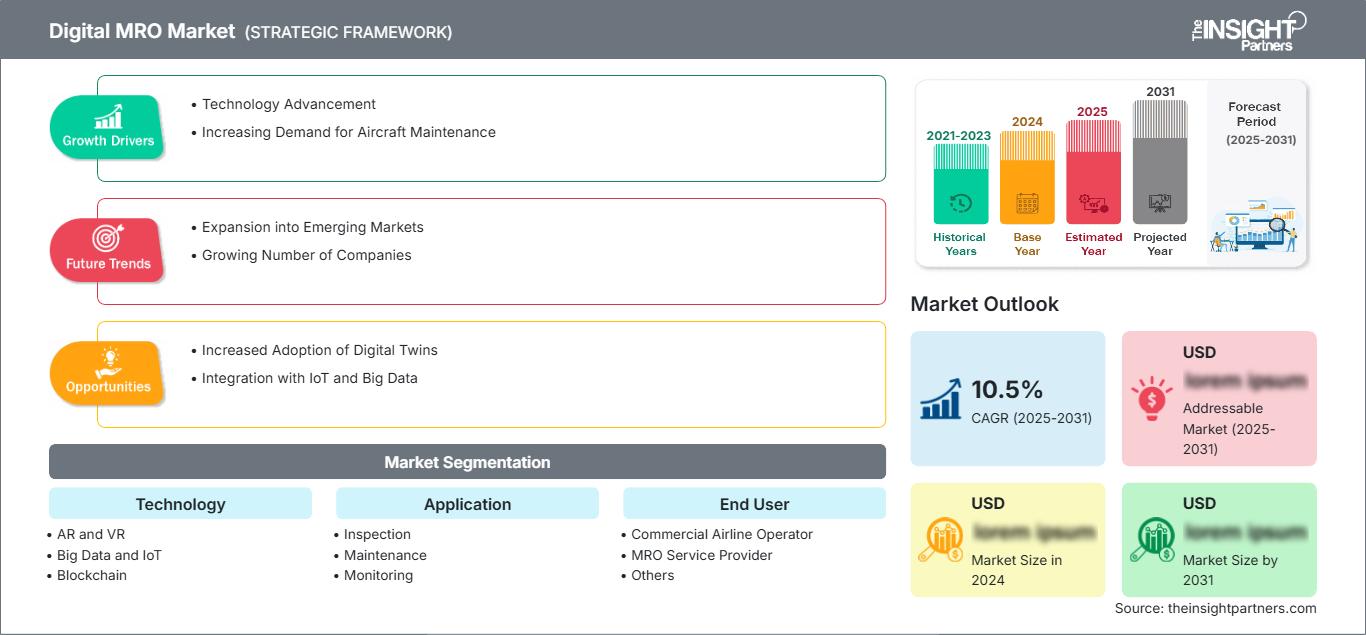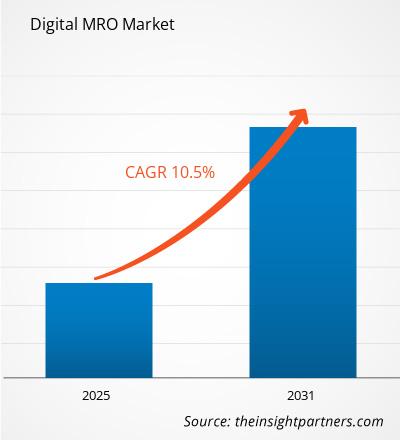Si prevede che il mercato MRO digitale registrerà un CAGR del 10,5% dal 2025 al 2031, con una dimensione del mercato in espansione da XX milioni di dollari nel 2024 a XX milioni di dollari entro il 2031.
Il rapporto è segmentato per tecnologia (AR e VR, Big Data e IoT, Blockchain, Digital Twin, Robotica e droni, altri), applicazione (ispezione, manutenzione, monitoraggio, formazione, altri), utente finale (operatore di compagnie aeree commerciali, fornitore di servizi MRO, altri). L'analisi globale è ulteriormente suddivisa a livello regionale e per i principali paesi. Il rapporto offre il valore in USD per l'analisi e i segmenti sopra indicati.
Scopo del rapporto
Il rapporto Digital MRO Market di The Insight Partners mira a descrivere il panorama attuale e la crescita futura, i principali fattori trainanti, le sfide e le opportunità. Ciò fornirà spunti a vari stakeholder aziendali, come:
- Fornitori/produttori di tecnologia: per comprendere le dinamiche di mercato in evoluzione e conoscere le potenziali opportunità di crescita, consentendo loro di prendere decisioni strategiche informate.
- Investitori: per condurre un'analisi completa delle tendenze in merito al tasso di crescita del mercato, alle proiezioni finanziarie del mercato e alle opportunità esistenti lungo la catena del valore.
- Organismi di regolamentazione: per regolamentare le politiche e le attività di controllo nel mercato con l'obiettivo di ridurre al minimo gli abusi, preservare la fiducia degli investitori e sostenere l'integrità e la stabilità del mercato.
Tecnologia di segmentazione del mercato MRO digitale
- AR e VR
- Big Data e IoT
- Blockchain
- Digital Twin
- Robotica e droni
- Altri
Applicazione
- Ispezione
- Manutenzione
- Monitoraggio
- Formazione
- Altri
Utente finale
- Operatore di compagnie aeree commerciali
- Fornitore di servizi MRO
- Altri
Geografia
- Nord America
- Europa
- Asia-Pacifico
- Sud e Centro America
- Medio Oriente e Africa
Potrai personalizzare gratuitamente qualsiasi rapporto, comprese parti di questo rapporto, o analisi a livello di paese, pacchetto dati Excel, oltre a usufruire di grandi offerte e sconti per start-up e università
Mercato MRO digitale: Approfondimenti strategici

-
Ottieni le principali tendenze chiave del mercato di questo rapporto.Questo campione GRATUITO includerà l'analisi dei dati, che vanno dalle tendenze di mercato alle stime e alle previsioni.
Fattori di crescita del mercato MRO digitale
- Progresso tecnologico: il crescente progresso tecnologico e la crescente integrazione delle tecnologie di intelligenza artificiale, realtà aumentata/virtuale e stampa 3D stanno agendo da importanti motori per il mercato.
- Crescente domanda di manutenzione degli aeromobili: uno dei principali fattori trainanti della crescita è la crescente richiesta di servizi di manutenzione degli aeromobili, sia commerciali che militari, che sta agendo da importante flusso per il mercato.
Tendenze future del mercato MRO digitale
- Espansione nei mercati emergenti: ci sono enormi opportunità di crescita nelle economie emergenti, poiché il mondo intero si sta concentrando sul settore aerospaziale e della difesa. Con il progresso nello sviluppo delle capacità produttive aeronautiche nei vari Paesi, la domanda di MRO digitale aumenterà.
- Numero crescente di aziende: il crescente numero di aziende che offrono MRO digitale in tutto il mondo sta anche stimolando l'intensa concorrenza, che si prevede guiderà la crescita del mercato nel periodo di previsione.
Opportunità di mercato per l'MRO digitale
- Maggiore adozione di gemelli digitali: il termine gemelli digitali sta guadagnando popolarità nel mercato dell'MRO digitale. Si tratta di una tecnologia in grado di creare un modello virtuale di un aeromobile o dei suoi componenti per pianificare ed eseguire i processi di manutenzione in modo più preciso.
- Integrazione con IoT e Big Data: l'integrazione di soluzioni MRO digitali nel campo dell'analisi dei big data e dell'IoT offre grandi opportunità. Ciò consentirebbe alle aziende di potenziare le proprie capacità di manutenzione, ottimizzare la gestione dell'inventario e migliorare i processi decisionali.
Approfondimenti regionali sul mercato MRO digitale
Le tendenze e i fattori regionali che influenzano il mercato MRO digitale durante il periodo di previsione sono stati ampiamente spiegati dagli analisti di The Insight Partners. Questa sezione illustra anche i segmenti e la geografia del mercato MRO digitale in Nord America, Europa, Asia-Pacifico, Medio Oriente e Africa, America meridionale e centrale.
Ambito del rapporto sul mercato MRO digitale
| Attributo del rapporto | Dettagli |
|---|---|
| Dimensioni del mercato in 2024 | US$ XX million |
| Dimensioni del mercato per 2031 | US$ XX Million |
| CAGR globale (2025 - 2031) | 10.5% |
| Dati storici | 2021-2023 |
| Periodo di previsione | 2025-2031 |
| Segmenti coperti |
By Tecnologia
|
| Regioni e paesi coperti |
Nord America
|
| Leader di mercato e profili aziendali chiave |
|
Densità degli operatori del mercato MRO digitale: comprendere il suo impatto sulle dinamiche aziendali
Il mercato MRO digitale è in rapida crescita, trainato dalla crescente domanda degli utenti finali dovuta a fattori quali l'evoluzione delle preferenze dei consumatori, i progressi tecnologici e una maggiore consapevolezza dei vantaggi del prodotto. Con l'aumento della domanda, le aziende stanno ampliando la propria offerta, innovando per soddisfare le esigenze dei consumatori e sfruttando le tendenze emergenti, alimentando ulteriormente la crescita del mercato.

- Ottieni il Mercato MRO digitale Panoramica dei principali attori chiave
Punti di forza
- Copertura completa: il rapporto analizza in modo esaustivo prodotti, servizi, tipologie e utenti finali del mercato MRO digitale, offrendo una panoramica olistica.
- Analisi degli esperti: il rapporto è redatto sulla base della conoscenza approfondita di esperti e analisti del settore.
- Informazioni aggiornate: il rapporto garantisce la pertinenza aziendale grazie alla copertura di informazioni e tendenze dei dati recenti.
- Opzioni di personalizzazione: questo rapporto può essere personalizzato per soddisfare le esigenze specifiche del cliente e adattarsi in modo appropriato alle strategie aziendali.
Il rapporto di ricerca sul mercato MRO digitale può quindi contribuire a guidare il percorso di decodificazione e comprensione dello scenario del settore e delle prospettive di crescita. Sebbene possano esserci alcune valide preoccupazioni, i vantaggi complessivi di questo rapporto tendono a superare gli svantaggi.
- Analisi storica (2 anni), anno base, previsione (7 anni) con CAGR
- Analisi PEST e SWOT
- Valore/volume delle dimensioni del mercato - Globale, Regionale, Nazionale
- Industria e panorama competitivo
- Set di dati Excel
Report recenti
Rapporti correlati
Testimonianze
Motivo dell'acquisto
- Processo decisionale informato
- Comprensione delle dinamiche di mercato
- Analisi competitiva
- Analisi dei clienti
- Previsioni di mercato
- Mitigazione del rischio
- Pianificazione strategica
- Giustificazione degli investimenti
- Identificazione dei mercati emergenti
- Miglioramento delle strategie di marketing
- Aumento dell'efficienza operativa
- Allineamento alle tendenze normative






















 Ottieni un campione gratuito per - Mercato MRO digitale
Ottieni un campione gratuito per - Mercato MRO digitale